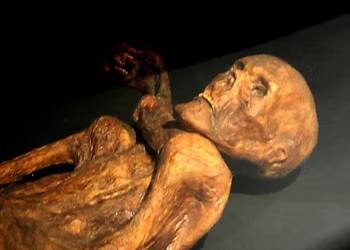

Damir Deljanin
Jan 10, 2023
Natural Ice Mummy
If you're learning German or planning to live in a German-speaking area, it's interesting to know about Ötzi, a natural ice age mummy. His story often appears in German language textbooks, as it is part of the general knowledge that children in Germany acquire from an early age.

Ötzi, also called Ötzi the Iceman, is a natural mummy of a man who lived between 3350 and 3105 BC, discovered in September 1991 in the Ectal Alps (hence the nickname "Etzi") on the border between Austria and Italy.
Eci is believed to have been killed by an arrowhead found lodged in his left shoulder in addition to various other wounds, and the nature of his life and the circumstances of his death are the subject of much research and speculation.
He is the oldest known natural human mummy in Europe, offering an unprecedented view of Copper Age Europeans. His body and belongings are on display at the Archaeological Museum of South Tyrol in Bolzano, Italy.
One day in September, the Simon couple from Nuremberg discovered a corpse in a glacier while hiking in the Tyrolean Alps. Helmut Simon thought it was a pile of old clothes and a pile of garbage, but his wife Erika recognized that it was a human being. In time, Pathologists noticed that it was a very old corpse, and through radiocarbon dating they realized that the body was 5300 years old.

We know a lot about his last days. They were heavy. He must have been in great pain, he was most likely on the run, or at least excluded from his clan. We know exactly what he ate just before he died. He was probably already wounded then. He ate the high-fat meat of the Alpine Ibex, along with bread and salad.
Then, ten to twenty minutes after the meal, an arrow must have hit him from behind. He died quickly, the stomach stopped, the food remained as it was. The arrowhead is still in it today. If the man had not died immediately from the arrow wound, the blow to the head could have cost him his life not long after. Someone – perhaps his killer – removed the wooden part of the arrow from the body not long after. But he didn't take anything of value with him. Ötzi had some arrows with him. But most of them were not finished, not even his bow. He just started making these things during his journey. Ötzi's cap is made of bear fur and his clothes are made of goat skin.

It's just amazing that we got something out of the ice that's been there for 5300 years. For a while it seemed that this body could no longer exist on our earth. His home is also a glacier. And if global warming progresses, the melting of glaciers and soil will reveal even more unknown people and animals to us, as a last consolation gift before the planet slowly becomes an uninhabitable space.

The film based on the reconstructed life of Ötzi was a big hit in German cinemas and is called "Der Mann aus dem Eis" (the man from the ice). The film may not be the best for learning German, because it mostly uses some Indo-European dialect, enriched with some words, for the needs of the film, which resembles a Tyrol dialect.
In German lessons through German Everywhere, you can discover more about the culture and history of the German-speaking area, while learning the language in an interesting and practical way. Join in and connect learning with fascinating stories from the past!




